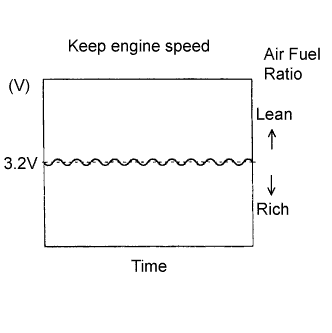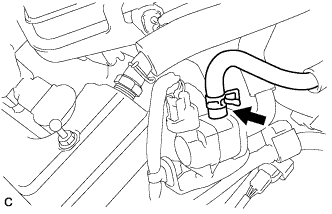Emission Control System -- On-Vehicle Inspection |
| 1. INSPECT AIR FUEL RATIO COMPENSATION SYSTEM |
Connect the intelligent tester to the DLC3.
 |
Select "DATA LIST". Then select "AFS B1 S1", "AFS B2 S1", "O2S B1 S2" and "O2S B2 S2" to display the monitors.
Warm up the air fuel ratio sensor with the engine speed at 2,500 rpm for approximately 2 minutes.
Maintain the engine speed at 2,500 rpm and confirm that the displays of "AFS B1 S1" and "AFS B2 S1" are as shown in the illustration.
- HINT:
- The illustration may differ slightly from the display on the intelligent tester.
- Only the intelligent tester displays the waveform of the air fuel ratio sensor.
 |
Confirm that the display of "O2S B1 S2" and "O2S B2 S2" changes between 0 and 1 V with the engine speed at 2,500 rpm.
| 2. INSPECT FUEL CUT OFF / RESTART RPM |
Increase the engine speed to at least 2,500 rpm.
Use a sound scope to check for injector operating sounds.
Check that when the throttle lever is released, injector operating sounds stop momentarily (at 2,500 rpm) and then resume (at 1,400 rpm).
- Standard:
Item Specified Condition Fuel cut off rpm 2,500 rpm Fuel injector restart rpm 1,400 rpm
| 3. VISUALLY INSPECT HOSE, CONNECTIONS AND GASKETS |
Check for cracks, leaks or damage.
- HINT:
- Separation of the engine oil dipstick, oil filler cap, PCV hose, etc. may cause the engine to run improperly. Disconnection, looseness or cracks in the parts of the air induction system between the throttle body and cylinder head will allow air suction and cause the engine to run improperly.
 |
| 4. INSPECT EVAPORATIVE EMISSION CONTROL SYSTEM |
Start the engine. Disconnect the vacuum hose as shown in the illustration.
 |
Connect the intelligent tester to the DLC3.
 |
Select the following menus: Powertrain / Active Test / Activate the VSV for EVAP Control.
Check that a vacuum occurs at the VSV port.
Exit Active Test mode and reconnect the vacuum hose.
Select the following menus: Powertrain / Engine / Data List / EVAP Purge VSV.
Check operation of the EVAP VSV.
Warm up the engine and drive the vehicle. Confirm that the EVAP VSV is opened.
If the result is not as specified, replace the VSV, wire harness or ECM.